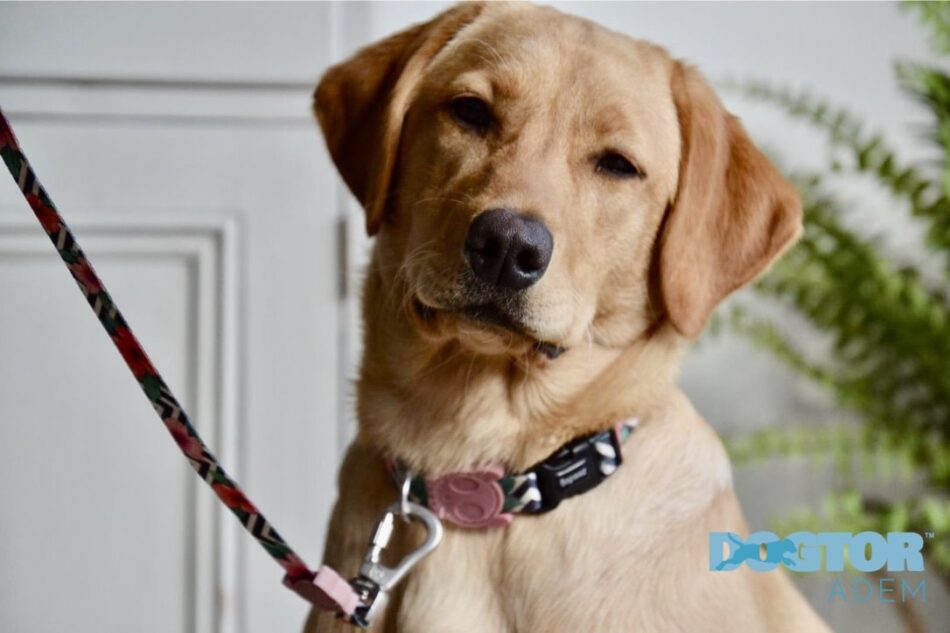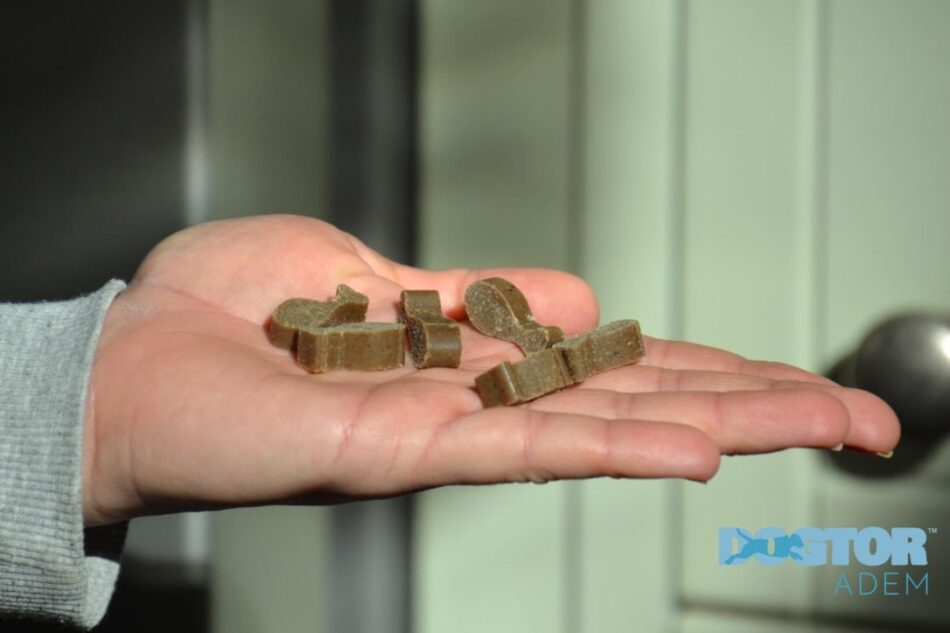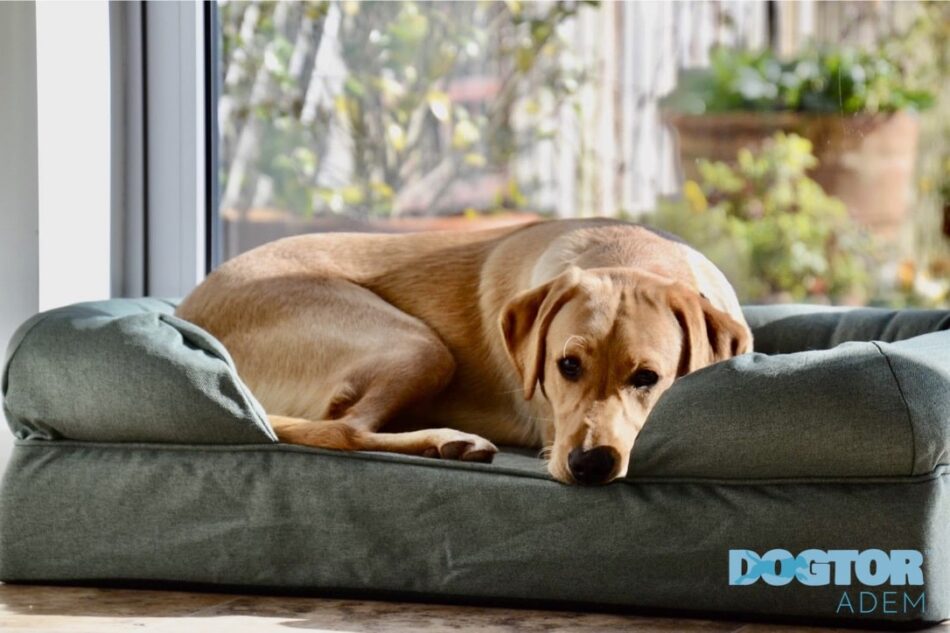How to Teach Your Dog the Command ‘Go to Bed’

Dogtor Adem, founder and owner of Dog-Ease, is a dog behaviourist and trainer with over 15 years experience working with dog owners and their canine best friends. In this blog post, Adem shows you how to teach your dog the “go to bed” command.
Using their fabulous new Bolster Bed, I have teamed up with Omlet to guide you through the basics of how to teach your dog the ‘Go to Bed’ command. ‘Go to Bed’ is a useful exercise for dog owners and can be used in a variety of situations, from being able to answer the front door knowing your dog is safely on their bed, away from external risks, or to allow guests to enter the home, to encouraging your dog to settle on a blanket or bed whilst visiting family, friends or even the local coffee shop!
Furthermore, whilst teaching this command you can also start to teach the basics of the commands ‘sit’, ‘heel’, ‘down’ and ‘leave’. All in all, it’s a great all round training exercise that can help you to be able to communicate with your dog effectively as well as helping our dogs to understand a range of commands that can be useful in our everyday lives in a variety of situations.
What you will need
- A comfortable dog bed (we can vouch for the Bolster Dog Bed!)
- Some tasty treats your dog likes
- Your dog on a lead and collar
- A clear area where you can walk at least 5-10 paces away from the dog bed
Helpful tips for beginning your training
1) To teach your dog the command ‘go to bed’, follow the steps outlined below. Start slowly, taking your time with each step. Your dog will need time to understand each step and master it. The training is designed to be carried out, repeated, and built on over time. Your dog will not be able to learn the command within a day! Just like us, dog’s need time to process, practice and fully learn new skills. It’s even harder for them to learn a skill when they speak ‘dog’ and we speak ‘human’! Our job as teachers is to help them to understand our language. This will take time and patience.
2) Use your tasty treats to reward your dog when they achieve what you are guiding them to understand. Give the treat as your dog carries out the command you are saying e.g. sit, helping them to associate the word you are saying with what they are doing at the time.
3) Carry out the training positively. Avoid telling your dog off and never force them into positions. They will not understand what this means and can form negative associations as a result. If your dog is not understanding, this is because they haven’t made the relevant connection between what you are saying and what they are required to do. Go back a step if this happens. It is your job to be a good and patient teacher!
4) Practice little and often. A good guide is to aim for 10-15 minutes of training at least once a day.
5) End your training sessions positively and on a ‘good note’. Accept small wins and small amounts of progress over pushing too quickly for too much from your dog, resulting in them not being able to do what you have asked of them. If the latter happens, go back to what they can do confidently and end there. You can come back to the next step another day. You want your dog to feel positive about what they have learnt and achieved, even if this is small, encouraging them to make the connections between what you are saying and what this means they should be doing at this time. This will also help them to want to participate next time!
6) Once you have mastered steps 1-5, repeat again using the ‘HOW TO PROGRESS’ tips to advance your training.
7) Finally, please do not attempt this training if your dog is showing signs of possessive or aggressive behaviour around food or items as this could put both yourself and your dog at risk. You should seek advice from a qualified behaviourist if this is the case.
And now to begin…
Step one: Set up your bed area and, with your dog on a lead, walk towards the bed
As outlined above, ensure that your dog bed is laid out in an area clear of obstacles. Ideally, you need to be able to walk 5-10 paces away from the bed in a relatively straight line. Put your dog on a lead and have your treats ready – preferably in a treat bag or easy access pocket so that you can access them quickly, ready to reward your dog for their achievements and cooperation!
Once your area and dog bed is set up, you have your tasty treats ready, and your dog on a lead by your side, walk up to your dog bed. You don’t have to walk far at first, 5 paces is sufficient at this early stage!
If your dog does not understand the ‘walk to heel’ command, hold a tasty treat to their nose as you walk to encourage them to walk on a loose lead by your side. Give the treat as a reward as you say the command ‘heel’ when your dog assumes the desired position by your side. You may need to hold the treat close to your dog’s nose to begin with if they don’t understand this command, helping them to stay close to your side as you walk.
HOW TO PROGRESS
- Increase the distance between you both and the bed so you have to walk further.
- When teaching ‘heel’, start to bring the treat away from their nose so they walk loosely on the lead without having to be directly lead by the scent of the yummy treat. Once your dog starts to understand they need to stay by your side, you can then progress to walking to ‘heel’ with the lead in your pocket, then to dropping the lead and the lead trailing on the floor, then finally to taking the lead off entirely! Take this slowly if your dog doesn’t know the heel command already.
Step two: Ask your dog to ‘sit’ in front of the bed
Stop in front of the dog bed and, holding a treat to your dog’s nose, guide your dog into the ‘sit’ position. As they place their bottom on the floor, say the command ‘sit’ so that they associate this word with the action of sitting. You can give a treat for assuming the sit position if they do not already know this command.
HOW TO PROGRESS
- Once your dog is sitting on command each time using the treat and word ‘sit’, start to complete STEP 2 without offering the treat so your dog begins to further understand what this word means when you say it.
Step three: Place a treat at the back of the bed and walk your dog back to the start position
Holding your dog’s lead in one hand, use your other hand to place a treat at the back of the dog bed.
Using a second treat, guide your dog away from the bed and the first tasty treat that you have placed at the back of the bed. As you move away from the bed and first treat you could also say the command ‘leave’. Remember, as with ‘heel’ and ‘sit’, say the command ‘leave’ as you move away and your dog assumes the correct action, following you rather than advancing towards the treat on the bed. To encourage your dog to move away from the bed, place the treat close to your dog’s nose to begin with to help them to understand what you are asking and to incentivise them to follow you.
Move back towards your start position by using the command ‘heel’. Remember to guide your dog with your treat, as before, back to the start position. Keep the treat close to their nose to begin with to help them walk closely by your side until they start to understand this command.

WHY TEACH THE LEAVE COMMAND?
The ‘leave’ command can be useful in everyday life, from teaching your dog to leave a child’s toy that is not suitable for them to play with, to asking them to leave a piece of food that you have dropped on the floor or they have found whilst walking that might not be suitable for them to eat. It is useful not only for helping your dog to understand what is his or hers, but also useful in keeping them safe from ingesting harmful objects or food items.
Step four: Turn to face the bed and ‘send’ your dog back to the bed using the ‘go to bed’ command
Once back at your start position, turn to face the bed and continue to use the treat to guide your dog into the ‘sit’ position once again. Give the treat as you say the command to once more positively reward the action as your dog carries it out.
Next, walk your dog back to the bed whilst saying ‘go to bed’ as the dog advances towards the bed (and the tasty treat you have placed there!)
HOW TO PROGRESS
- As with teaching the ‘heel’ command, you want your dog to eventually be able to complete this off lead. Start by dropping the lead on the floor and sending your dog to their bed whilst saying ‘go to bed’. You could add a hand signal, such as pointing at the bed, at this stage to help your dog to understand.
- Complete this step with your dog off lead and say ‘go to bed’.
Step five: Allow your dog to find the treat, say their name so they turn towards you, and then ask them to sit whilst on the bed
After walking or sending your dog to their bed, allow them to find and eat the tasty treat you placed on the bed earlier. Next, call their name to get their attention and, using another treat if necessary, ask or guide them into the ‘sit’ position. They should now be sat on their bed and, as a result, they have completed ‘go to bed’ in it’s simplest form! Move to your dog’s side (so they don’t advance forwards and off the bed) and give them the tasty treat for sitting on the bed.
HOW TO PROGRESS
- After you are consistently able to achieve a ‘sit’ on the bed, use a treat start to guide your dog into the down position instead of asking them to sit on the bed. Say the word ‘down’ as they assume the correct position. Reward as before by the dog’s side rather than in front to encourage them to stay laying on their bed.
- Once your dog is confidently laying down on the bed each time you say down, increase the distance from which you ask them to assume this position. If your dog is doing well with this, increase your distance from them each time by a step or two. The eventual aim is that you will be able to say the command from the other side of the room and your dog respond appropriately! As before, always go back to your dog’s side at the end of the exercise to reward them with a treat for laying on their bed.
So there you have it, the five steps to teaching your dog to ‘go to bed’! Over time, the repetition of this training along with your clear giving of commands and timely rewarding of their actions in response should help your dog to understand exactly what you are asking of them.
Let me know if you give it a go!

Dogtor™ Adem
Top UK Dog Trainer and Behaviourist
Owner of Dog-ease Training
www.dog-ease.co.uk
No comments yet - Leave a comment
This entry was posted in Dogs on March 11th, 2020 by linnearask
